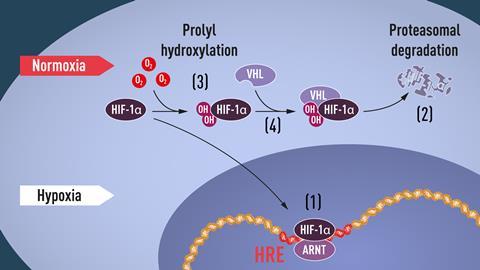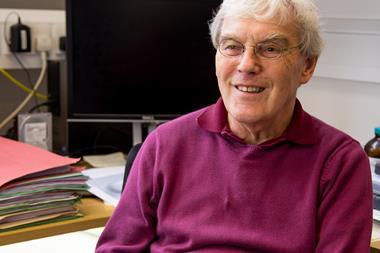
The 2019 physiology or medicine Nobel prize has been awarded to the scientist trio that uncovered how cells sense and adapt to changing oxygen levels. William Kaelin from Harvard University, US, Peter Ratcliffe from the UK’s University of Oxford, and Gregg Semenza from Johns Hopkins University, US, share this year’s prize for a discovery that has opened up new ways to fight cancer, anaemia, kidney disease and even heart attacks. Several drugs blocking oxygen-sensing enzymes – and thus stimulating red blood cell production – are currently in late stage clinical trials.
How the body makes use of and reacts to oxygen has long been a central theme in medical research. In 1931, Otto Warburg received a Nobel prize for revealing how enzymes in the mitochondria convert food into energy with the help of oxygen. Seven years later, the medicine Nobel prize was awarded to Corneille Heymans for finding out how chemoreceptors sense blood oxygen levels and control the body’s respiratory rate.
In the early 20th century, scientists already knew that the body responds to hypoxia – low tissue oxygen content – by raising its levels of erythropoietin. The hormone increases red blood cell production. But how oxygen controls this process remained a mystery until Semenza and Ratcliffe found the erythropoietin gene. In 1995, Semenza had also identified a pair of oxygen-sensitive proteins – the hypoxia-inducible factor (HIF) – that can control expression of the gene.

At the same time, Kaelin was studying von Hippel-Lindau (VHL) disease, a hereditary condition that causes tumours and excessive erythropoietin production. Kaelin found that the protein, which is defective in people with VHL, removes HIF in cells that contain enough oxygen. The VHL protein attaches ubiquitin to HIF, which signals the cell’s incinerator (the proteasome) to destroy it.
In 2001, both Kaelin and Ratcliffe showed that under normal oxygen levels a protein called prolyl hydroxylase attaches hydroxyl groups to HIF. This allows the VHL protein to recognise HIF and label it for degradation.
But illnesses occur when oxygen sensing goes wrong. In certain types of cancer, tumour cells’ altered oxygen regulation leads to the formation of new cancer cells. This is why pharma companies are now working on drugs that either activate or block the oxygen-sensing mechanism.
‘Thanks to this research we know much more about how different levels of oxygen impact on physiological processes in our bodies,’ said Bridget Lumb, president of the Physiological Society. ‘This has huge implications for everything from recovery from injury and protection from disease, through to improving exercise performance.’
‘This is really a textbook discovery,’ said Randall Johnson, member of the Nobel Assembly. ‘This is something that basic biology students will be learning about when they study the fundamental ways in which cells work.’
In 2016, the trio shared the Lasker award for basic medical research, and this prize is often a good predictor for who might win a Nobel prize. Since the award’s inception in 1945, 86 Lasker awardees have received Nobel prizes. While neither laureate was included in predictions made this year, last year’s Sigma Xi prediction contest did indeed include Semenza and Ratcliffe – though they were knocked-out in the semi-finals.

















No comments yet